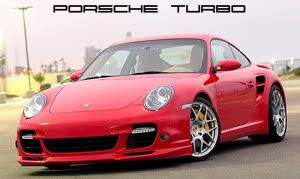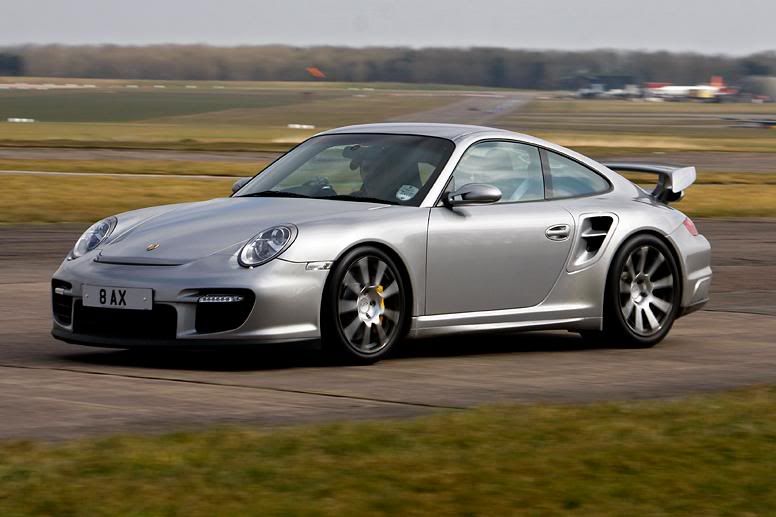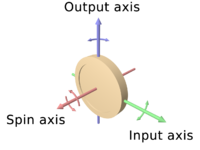cannga:
Very interesting (please note I didn't say right, or wrong, just interesting  ) exchange (on 6speedonline.com) on light versus heavy wheel and gyroscopic effect. The guys there don't post here and vice versa, so let me provide the quote.
) exchange (on 6speedonline.com) on light versus heavy wheel and gyroscopic effect. The guys there don't post here and vice versa, so let me provide the quote.
>>>>>>>>>>>>>>>>>>>>>
Originally Posted by
Tech1_Mike 
I have the utmost respect for the entire Ruf organization.
Alois Ruf is an innovator par excellence!
That said, I disagree that the gyroscopic effect contributes to stability. No road surface is smooth enough to escape all the effects of gyroscopic precession. Every force applied to a rotating body causes the "gyroscope" to precess in a direction 90 degrees from the applied force. This is one reason why heavy wheels resist turning. (The other is kinetic energy).
Unfortunately, every bump or irregularity in the road, regardless how small, causes these forces to be applied and this precession reaction to occur. The heavier the wheel, the greater the force and the greater the reaction. In addition, the heavier the wheel, the more the impact force is transmitted to the suspension and to the car itself. It's physics. And it is inescapable...
If you were, like me  , wondering what on earth PRECESSION is, take a couple aspirins (doctor's order LOL) and follow the article below.
, wondering what on earth PRECESSION is, take a couple aspirins (doctor's order LOL) and follow the article below.
BTW, I am **still** wondering about the 40,000 rpm flywheel in the GT3 R hybrid and whether its gyroscopic effect affects handling, for example when the car is banking at an oval track. Does it have to be near the center of rotation of the car in all planes, so that it sees minimal yaw/pitch/roll angles?
>>>>>>>>>>>>>>>>>>
http://en.wikipedia.org/wiki/Precession
Precession is a change in the orientation of the rotation axis of a rotating body. It can be defined as a change in direction of the rotation axis in which the second Euler angle (nutation) is constant. In physics, there are two types of precession: torque-free and torque-induced.
In astronomy, "precession" refers to any of several slow changes in an astronomical body's rotational or orbital parameters, and especially to the Earth's precession of the equinoxes. See Precession (astronomy).
..................
Torque-induced
Torque-induced precession (gyroscopic precession) is the phenomenon in which the axis of a spinning object (e.g. a part of a gyroscope) "wobbles" when a torque is applied to it. The phenomenon is commonly seen in a spinning toy top, but all rotating objects can undergo precession. If the speed of the rotation and the magnitude of the torque are constant the axis will describe a cone, its movement at any instant being at right angles to the direction of the torque. In the case of a toy top, if the axis is not perfectly vertical the torque is applied by the force of gravity tending to tip it over.

The response of a rotating system to an applied torque. When the device swivels, and some roll is added, the wheel tends to pitch.
The device depicted on the right here is gimbal mounted. From inside to outside there are three axes of rotation: the hub of the wheel, the gimbal axis and the vertical pivot.
To distinguish between the two horizontal axes, rotation around the wheel hub will be called 'spinning', and rotation around the gimbal axis will be called 'pitching.' Rotation around the vertical pivot axis is called 'rotation'.
First, imagine that the entire device is rotating around the (vertical) pivot axis. Then, spinning of the wheel (around the wheelhub) is added. Imagine the gimbal axis to be locked, so that the wheel cannot pitch. The gimbal axis has sensors, that measure whether there is a torque around the gimbal axis.
In the picture, a section of the wheel has been named dm1. At the depicted moment in time, section dm1 is at the perimeter of the rotating motion around the (vertical) pivot axis. Section dm1 therefore has a lot of angular rotating velocity with respect to the rotation around the pivot axis, and as dm1 is forced closer to the pivot axis of the rotation (by the wheel spinning further), due to the Coriolis effect dm1 tends to move in the direction of the top-left arrow in the diagram (shown at 45°) in the direction of rotation around the pivot axis. Section dm2 of the wheel starts out at the vertical pivot axis, and thus initially has zero angular rotating velocity with respect to the rotation around the pivot axis, before the wheel spins further. A force (again, a Coriolis force) would be required to increase section dm2's velocity up to the angular rotating velocity at the perimeter of the rotating motion around the pivot axis. If that force is not provided, then section dm2's inertia will make it move in the direction of the top-right arrow. Note that both arrows point in the same direction.
The same reasoning applies for the bottom half of the wheel, but there the arrows point in the opposite direction to that of the top arrows. Combined over the entire wheel, there is a torque around the gimbal axis when some spinning is added to rotation around a vertical axis.
It is important to note that the torque around the gimbal axis arises without any delay; the response is instantaneous.
In the discussion above, the setup was kept unchanging by preventing pitching around the gimbal axis. In the case of a spinning toy top, when the spinning top starts tilting, gravity exerts a torque. However, instead of rolling over, the spinning top just pitches a little. This pitching motion reorients the spinning top with respect to the torque that is being exerted. The result is that the torque exerted by gravity - via the pitching motion - elicits gyroscopic precession (which in turn yields a counter torque against the gravity torque) rather than causing the spinning top to fall to its side.
Precession or gyroscopic considerations have an effect on bicycle performance at high speed. Precession is also the mechanism behind gyrocompasses.
Gyroscopic precession also plays a large role in the flight controls on helicopters. Since the driving force behind helicopters is the rotor disk (which rotates), gyroscopic precession comes into play. If the rotor disk is to be tilted forward (to gain forward velocity), its rotation requires that the downward net force on the blade be applied roughly 90 degrees (depending on blade configuration) before, or when the blade is to one side of the pilot and rotating forward.
To ensure the pilot's inputs are correct, the aircraft has corrective linkages which vary the blade pitch in advance of the blade's position relative to the swashplate. Although the swashplate moves in the intuitively correct direction, the blade pitch links are arranged to transmit the pitch in advance of the blade's position.
--
Regards,
Can
997 Turbo + Bilstein Damptronic "Stage 2" ( Review ) + GIAC ECU Tune ( Fast as a torpedo & reversible to stock - Review ) + Cargraphic Exhaust ( Oh heavenly noise!  )
)

 )
)![]()






 , I am sure you must have a good reason for stating unsprung weight is good in motorsports? (Not sarcastic at all, I *know* you have some explanation.)
, I am sure you must have a good reason for stating unsprung weight is good in motorsports? (Not sarcastic at all, I *know* you have some explanation.)













 See animation below.
See animation below.

 Good thing I didn't post the one on conservation of angular momentum? That read goes well with extra strength aspirin -- and it still may not make any sense. LOL
Good thing I didn't post the one on conservation of angular momentum? That read goes well with extra strength aspirin -- and it still may not make any sense. LOL



 as the displacement of particle i from the centre of mass, and
as the displacement of particle i from the centre of mass, and  as the velocity of particle i with respect to the centre of mass, then we have
as the velocity of particle i with respect to the centre of mass, then we have and
and 
 and
and 









